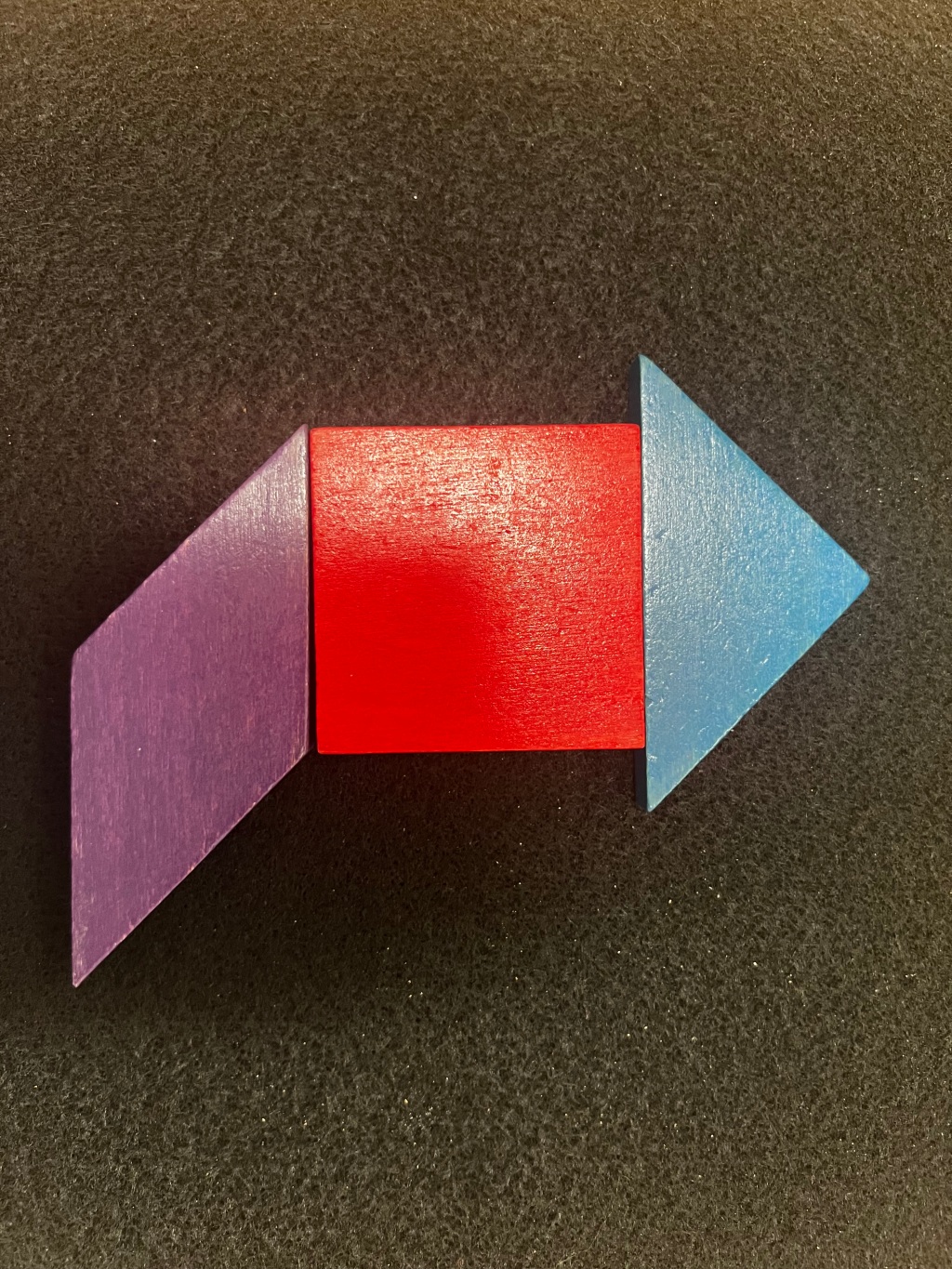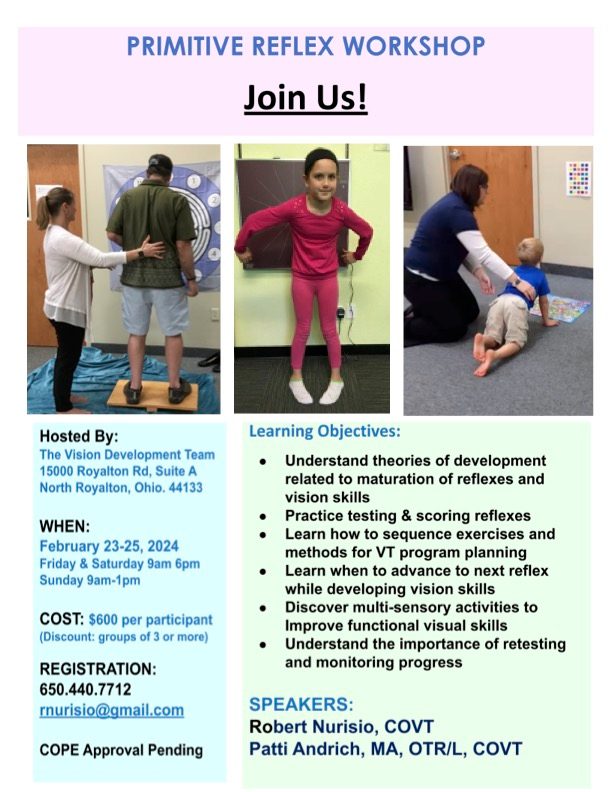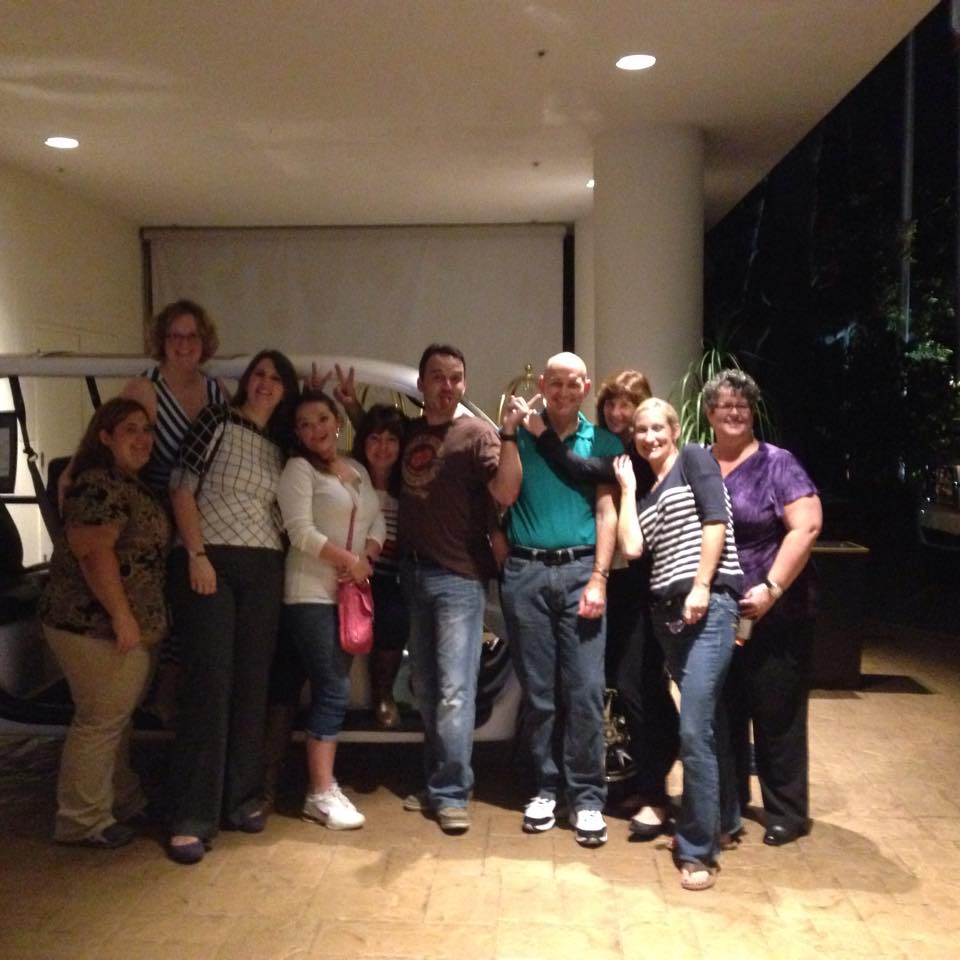This post appears as part of a series called Sit Down – candid conversations with real people detailing their journeys and experiences with Vision Therapy.
A Sit Down – with Dr. Jill Schultz
For the benefit of our readers, can you explain how you are involved in Developmental Optometry?
I have been a developmental/pediatric/neuro-rehabilitative optometrist for the last ten years. Yikes-time really flies when you are having fun! In fact, this year I will be headed back to Pacific University for my 10 year class reunion. I grew up in Minnesota, attended University of Minnesota-Duluth, Pacific University College of Optometry and then completed the Pediatric and Vision Therapy residency at Southern California College of Optometry. I returned to Minnesota and opened a practice cold that has now grown into a two location (Otsego and Minnetonka, MN), full scope/pediatric/VT/neuro-rehab specialty practice. This year we launched a private practice residency program affiliated with Pacific University College of Optometry.
What led you to Developmental Optometry?
I’ve always been interested in children and health care. At Pacific I learned about Developmental Optometry right away; our first semester included an entire course named Behavioral Optometry that I feel framed my future education. I enjoyed all aspects of optometry, but felt drawn to the developmental aspects due to such an unmet need. I felt I had to help or no one else would. I have a big heart for those that struggle due to my own vision issues. Even though I’m essentially emmetropic (but have been accused of being a myope-thank you Dr. Rob Lewis?!), I unknowingly had terrible eye movement skills. I always did well in school, but had to study, wasn’t a fan of reading novels and had no interest in sports. During Optometry school I realized I had oculomotor dysfunction and eye movement skills equivalent to a third grader on the Visagraph! No one, including myself, knew how hard I was working. Having that background likely impacted my path. Developmental Optometry is never the same and requires creativity, flexibility and problem solving to meet the needs of each specific patient. I have found it challenging, but extremely fun and rewarding.
In the world of vision care, there is a big difference between seeking a “second opinion” and a “different opinion”. When this distinction is ignored or overlooked, much confusion is created and many parents are at a loss. Can you explain the difference?
I run into this a lot unfortunately. Often times a well intended pediatrician suggests a “second opinion” with a Pediatric Ophthalmologist. The parent is given different advice and left very confused. Ophthalmologists are trained in surgical procedures and the structure of the eyes and visual system. Optometrists also are trained in these treatments, but also in the function of the visual system and non-surgical treatment options. For example, Developmental Optometrists recognize strabismus as a neuro-developmental condition that impacts the whole child and not just cosmetic eye alignment. We are concerned with the spatial, motor and cognitive implications that strabismus has on the person and how activities of daily living may be impacted. Our approach would be to prevent or rehabilitate these areas to improve function. A purely structural approach would be to cut and reattach eye muscles so the eyes appear more aligned. The difference in philosophy creates confusion and in reality we should work together for the benefit of the patient. If we did, surgical outcomes would be much better.
On the topic of strabismus, many parents become concerned when their baby develops an eye turn and receives a diagnosis of Accommodative Esotropia. Can you explain why some babies seem to be using both eyes at birth and develop an eye turn before their second birthday?
This can be the case in a few different scenarios. First, pathology can cause acquired esotropia and should be ruled out. Second, it is possible that the child had crossed eyes earlier, but it wasn’t as noticeable. As time passes, the condition worsens and becomes more embedded, causing the appearance to worsen. Third, there is a type of eye crossing called Accommodative Esotropia that typically presents around 2-3 years of age and is associated with farsightedness. At around this age, children develop more mature accommodative skills (aka focusing skills) and in order to see clearly they must accommodate (or focus), which results in esotropia. Many parents notice the crossing only intermittently during mealtime as this is a time they observe the child focusing at near. Fortunately, in most cases this condition can be controlled with glasses or contact lenses. This diagnosis can be a blessing as can be the only indication (without a comprehensive vision examination) that a child is very farsighted and requires glasses to see, especially for near distances. Having clear and comfortable vision at near distances is important for visual development, in addition to speech, cognitive and fine motor skills.
What is your approach when treating a child younger than two years old who has an eye turn? Is it different if the eye is turned in versus out?
Early intervention is best so seeing a child as early as possible is ideal (InfantSEE offers free eye exams for children 6-12 months: www.infantsee.org) in order to prevent the strabismus from worsening and the brain adapting to the condition. After completing a full evaluation and ruling out pathology, my first treatment approach would be to provide the best lens prescription possible to aid in binocularity. Next, I typically recommend bi-nasal occlusion to prevent adaptations associated with a dysfunctional visual system like cross fixation and suppression. We have been very successful in pairing traditional vision therapy with vestibular/reflexively-driven eye movement techniques. I have learned so much from my buddies Drs. Curt Baxstrom and Jason Clopton in this area and I strongly suggest their courses. Working with the toddler age group can be challenging in a therapy setting. Some families do a fantastic job of working together and some do not. The activities must be age appropriate and fun. Follow up is critical to maintain motivation for the parents and assess home therapy techniques. There are some different considerations between management of exotropia and esotropia, but generally my approach would be very similar.
Do you feel long term patching can be a successful treatment with strabismus?
I should mention that my approach in treating strabismus, particularly young esotropes, is very different now compared to when I first started practicing. I feel that I received a wonderful education in school and during my residency; however, I had a more medical model treatment strategy. I tended to prescribe more patching and did not have the experience with the vestibular therapy tools I have now. In my experience (with my patients and the many patients that I have worked seeking another opinion from ophthalmology) a patching only treatment strategy is not very effective in the treatment of strabismus. Early in my career I was worried that I was doing harm by not sending an infantile esotrope for surgery, but did not feel good about it. Now I know surgery at that age would cause more harm and that the esotropia is likely a symptom of a dysfunction the visual-motor-vestibular feedback system. The brain must learn a new strategy to use both right and left visual pathways simultaneously and fuse; patching alone will not provide this. Patching can be one tool to break down suppression and train various monocular skills, but without all the other steps involved to provide a scaffolding of visual perception, there is little hope for success.
Some professionals view strabismus surgery as a valuable resource when done in coordination with Vision Therapy, while others disagree. Do you feel there are times strabismus surgery is warranted?
I think that strabismus surgery is a valuable treatment option and feel that it is my duty to explain all options, including surgery. My job is to present the options and allow the patient to decide what is best for them after knowing the pros and cons. Some patients only care about having the appearance of straight eyes, don’t value the functional aspects of binocular vision. We all want that “magic pill” or quick fix. However, in my experience, once patients/parents realize that strabismus surgery does not result in depth perception, a normally functioning visual system or remedy the associated learning-related issues, they often lose interest in pursuing surgical options. In some cases, surgery can be a tool to help a patient maintain alignment after they are capable of sensory fusion after vision therapy if needed.
If a Pediatrician or Ophthalmologist downplays the effectiveness of Vision Therapy to one of your patients, and further recommends surgery as the only answer for strabismus, how do you reassure your patients that Vision Therapy is a viable treatment option?
I do my best to educate them about the difference in training between the two professions, which explains the difference in opinion. Strabismus is not an eye issue, but rather a brain issue so retraining the brain-eye pathways is needed to provide function. By providing patients and parents information and education about the condition, hopefully most patients will realize that there isn’t a magical quick fix. Everyone processes information differently (often parents have genetically similar deficits to their children) so having different tools available, such as websites, the VisionHelp blog, referenced studies, or a conversation with a vision therapy graduate can be helpful. I want them to know how the condition impacts development, spatial processing skills and learning-not just eye alignment. Unfortunately, sometimes we don’t get the second opportunity to educate patients before they make a decision due to political crap and ignorance.
Questions often arise on the ideal age for Vision Therapy candidates. If a child is showing signs of strabismus between 6 and 18 months, would you recommend Vision Therapy activities to nurture binocular development?
Definitely! There is nothing to lose by providing a child experiences to develop a normal binocular system. Vision is learned and we can steer visual development in the right direction.
Has being the mom of two young children enhanced or changed your perspective on proper vision development?
Having two boys is frightening given that 1 in 54 has a diagnosis of Autism and 1 in 5 is labeled with AD(H)D. I see the discrimination of vision therapy by the medical community and the promotion of surgery despite studies like the CITT. I have become a bit disenfranchised with the medical system based on these observations. However, I am encouraged by the brave parents that decide to follow our recommendations, sometimes against the advice of so-called experts. I have a lot of respect for parents that go rogue for their child and it is unbelievably awesome to see our treatments work despite the poor advice some have been given. Vision therapy is a lot of work and it amazes me how hard some families work to complete a program.
It is difficult to tease out vision from development. I feel that discipline and providing a non-toxic environment are huge in setting the stage for proper development and visual skills. Many children do not have boundaries and therefore are making choices that impact their future. By non-toxic I mean a healthy diet, experiences for exploring movement and minimal television/media influences. I can’t help but wonder if our children ate whole foods, had adequate sleep and were not exposed to chemicals (in medications, dyes and other junk) if those rates of Autism and ADD would be the same. Working with a child who comes in to the office drinking a huge can of Monster Energy, eating a bag Cheetos for breakfast and is socially checked out while playing a video game three inches from his face can be a challenge. I know I sound like a total no fun, wacko hippie lady, but I don’t care. My oldest son (pictured below) just called me “the sugar police” yesterday so I am used to it.
***NOTE – During the course of our interview, Dr. Schultz shared this picture, explaining she came downstairs early one morning to find her son reading this book in his underwear. Future Optometrist??? 🙂
In your model of vision, what role might Occupational Therapy play in the overall development of a child, and when do you feel a referral to an OT is warranted?
Vision is motor! As they say, strabismus is in the body, not just the eyes. Motor and visual pathways are neurologically paired so delays are often co-morbid. I feel that Optometrists have a duty to ask about developmental milestones and provide information to parents about possible concerns. We all see very young patients that struggle with sensory processing or motor skills. Even though many may not present with visual issues at the time, they are very likely to have visual difficulties in the future. If we can help sensory, motor and vestibular skills develop this will support optimal visual development. I make many referrals to occupational therapy. If we don’t do it, who will?
With the new school year beginning, many parents are unaware that their child’s academic struggles may be caused by a visually related learning issue. What are some of the classic signs or symptoms that you would recommend parents watch out for?
First, every child should have a comprehensive eye examination that assesses accommodation, vergence and oculomotor skills, especially any child with symptoms, difficulties in school or any developmental concern. A person with a learning-related vision problem is usually unable to identify or verbalize their symptoms as they have always had them or doesn’t have anything else to compare. They may also compensate for their difficulties to the point they are not obvious to others. Common signs and symptoms are: loss of place when reading, poor reading fluency, headaches, eye strain, holding book or reading material close to eyes, avoidance of reading, blurred vision, tired eyes when reading and difficulty coping from the board.
If you could waive your magic wand and change one thing about Developmental Optometry, what would it be?
Every child would have vision examinations so we could prevent and identify these treatable vision problems that interfere with learning, attention and behavior. Vision therapy would be accepted as a legitimate treatment that it is and that we were held to the same standards as other areas of medicine. Instead, we are expected to fill a bottomless pit with research. You said one thing, but since I have a magic wand I’d eliminate our struggles with insurance too. 🙂
Some closing thoughts – A great thanks to Dr. Jill Schultz for taking the time to share her insights. Formerly Dr. Hadler, she is just as thoughtful, hilarious and wonderful after marriage as she was before!! Please join me in wishing Dr. Schultz and her young family the absolute best! 🙂






Leave a comment